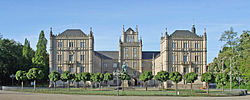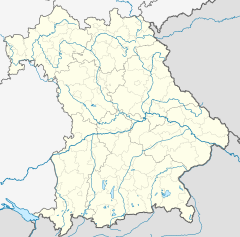
Saxe-Coburg and Gotha, or Saxe-Coburg-Gotha, was an Ernestine, Thuringian duchy ruled by a branch of the House of Wettin, consisting of territories in the present-day states of Thuringia and Bavaria in Germany. It lasted from 1826 to 1918. In November 1918, Charles Edward, Duke of Saxe-Coburg and Gotha, was forced to abdicate. In 1920, the northern part of the duchy was merged with six other Thuringian free states to form the Free State of Thuringia: Saxe-Weimar-Eisenach, Saxe-Altenburg and Saxe-Meiningen, Schwarzburg-Rudolstadt and Schwarzburg-Sondershausen, as well as the People's State of Reuss. The southern part of the duchy, as southernmost of the Thuringian states, was the only one which, after a referendum, became part of the Free State of Bavaria.
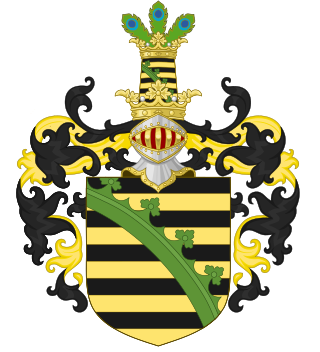
The House of Wettin was a dynasty of German kings, prince-electors, dukes, and counts that once ruled territories in the present-day German states of Saxony, Saxony-Anhalt and Thuringia. The dynasty is one of the oldest in Europe, and its origins can be traced back to the town of Wettin, Saxony-Anhalt. The Wettins gradually rose to power within the Holy Roman Empire. Members of the family became the rulers of several medieval states, starting with the Saxon Eastern March in 1030. Other states they gained were Meissen in 1089, Thuringia in 1263, and Saxony in 1423. These areas cover large parts of Central Germany as a cultural area of Germany.

Saxe-Coburg was a duchy held by the Ernestine branch of the Wettin dynasty in today's Bavaria, Germany.
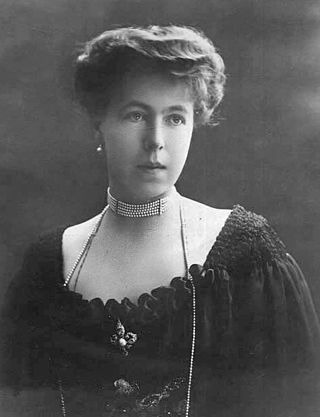
Princess Alexandra of Saxe-Coburg and Gotha was the fourth child and third daughter of Alfred, Duke of Saxe-Coburg and Gotha, and Grand Duchess Maria Alexandrovna of Russia. As the wife of Ernst II, she was Princess consort of Hohenlohe-Langenburg. She was a granddaughter of both Queen Victoria of the United Kingdom and Tsar Alexander II of Russia.

Coburg is a town located on the Itz river in the Upper Franconia region of Bavaria, Germany. Long part of one of the Thuringian states of the Wettin line, it joined Bavaria by popular vote only in 1920. Until the revolution of 1918, it was one of the capitals of the Duchy of Saxe-Coburg and Gotha and the Duchy of Saxe-Coburg-Saalfeld.

Princess Sibylla of Saxe-Coburg and Gotha was a member of the Swedish royal family and the mother of the current king of Sweden, Carl XVI Gustaf.
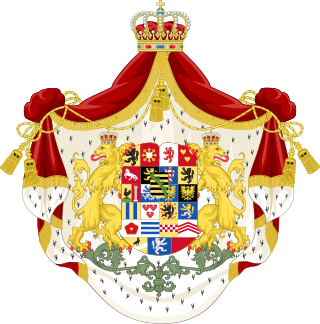
The House of Saxe-Coburg and Gotha is a European royal house. It takes its name from its oldest domain, the Ernestine duchy of Saxe-Coburg and Gotha, and its members later sat on the thrones of Belgium, Bulgaria, Portugal, and the United Kingdom and its dominions.

Saxe-Coburg-Saalfeld was one of the Saxon Duchies held by the Ernestine line of the Wettin Dynasty. Established in 1699, the Saxe-Coburg-Saalfield line lasted until the reshuffle of the Ernestine territories that occurred following the extinction of the Saxe-Gotha line in 1825, in which the Saxe-Coburg-Saalfeld line received Gotha, but lost Saalfeld to Saxe-Meiningen.

Prince Andreas of Saxe-Coburg and Gotha, Duke of Saxony is a German landowner and nobleman who has been the head of the House of Saxe-Coburg and Gotha since 1998. He is the grandson of Charles Edward, the last ruling duke of Saxe-Coburg and Gotha. He is thus a great-great grandson of Queen Victoria of the United Kingdom, by direct male line, and was a third cousin of Queen Elizabeth II.

Victoria Adelaide of Schleswig-Holstein-Sonderburg-Glücksburg was Duchess of Saxe-Coburg and Gotha as the consort of Duke Charles Edward from their marriage on 11 October 1905 until his abdication on 14 November 1918. Victoria Adelaide is the maternal grandmother of Carl XVI Gustaf of Sweden. She was a niece of German Empress Augusta Victoria.

Princess Anna Sophie of Schwarzburg-Rudolstadt was a Princess of Schwarzburg-Rudolstadt.
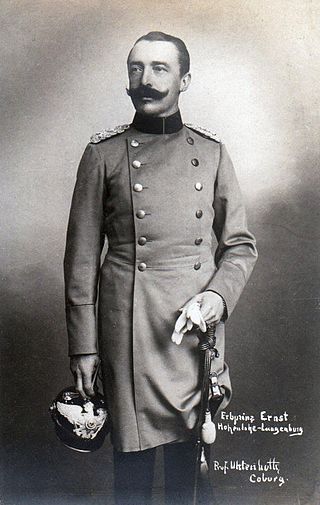
Ernst II was a German aristocrat and Prince of Hohenlohe-Langenburg. He served as the Regent of the Duchy of Saxe-Coburg and Gotha during the minority of his wife's cousin, Duke Charles Edward, from 1900 to 1905.

Princess Dorothea Maria Henriette Auguste Louise of Saxe-Coburg and Gotha was a princess of Saxe-Coburg and Gotha by birth and the duchess of Schleswig-Holstein through her marriage to Ernst Gunther, duke of Schleswig-Holstein. Dorothea was born in Vienna, Austria, the second child and only daughter of Prince Philipp of Saxe-Coburg and Gotha and Princess Louise of Belgium.
Prince Hubertus of Saxe-Coburg and Gotha was a German courier pilot and a member of the House of Saxe-Coburg-Gotha, which reigned over the eponymous duchy in the German Empire. Born a prince of Great Britain and Ireland as a great-grandson of Queen Victoria, Hubertus lost this title during the First World War. He became heir apparent to the headship of his house in 1932, and he never married. Hubertus joined the Nazi Party upon the outbreak of the Second World War despite his opposition to Adolf Hitler and Nazism. He served in the Luftwaffe on the Eastern Front until he was killed in action. He is the maternal uncle of King Carl XVI Gustaf of Sweden.

Schloss Rosenau, called in English The Rosenau or Rosenau Palace, is a former castle, converted into a ducal country house, near the town of Rödental, formerly in Saxe-Coburg, now lying in Bavaria, Germany.

The Veste Coburg is one of the best-preserved medieval fortresses of Germany. It is situated on a hill above the town of Coburg, in the Upper Franconia region of Bavaria.

The House of Saxe-Coburg and Gotha-Koháry is the Catholic cadet branch of the House of Saxe-Coburg and Gotha, founded after the marriage of Prince Ferdinand of Saxe-Coburg and Gotha and Princess Maria Antonia Koháry de Csábrág. Among its descendants were the last four kings of Portugal and the last three Tsars of Bulgaria. After the change of the “House laws” by King Simeon, the present head of the house is his sister Princess Marie Louise of Bulgaria, Princess of Koháry.

Callenberg Castle is a castle on a wooded hill in Beiersdorf, an Ortsteil of Coburg, 6 kilometres (3.7 mi) from the town centre. It was a hunting lodge and summer residence and has long been the principal residence of the House of Saxe-Coburg and Gotha. It is currently owned by Andreas, Prince of Saxe-Coburg and Gotha, who created the Ducal Saxe-Coburg and Gotha House Order. A large and architecturally important family chapel is contained within.

Friedenstein Palace is an early Baroque palace built in the mid-17th century by Ernest I, Duke of Saxe-Gotha at Gotha, Thuringia, Germany. In Germany, Friedenstein was one of the largest palaces of its time and one of the first Baroque palaces ever built. Friedenstein served as the main seat of the Dukes of Saxe-Gotha and later as one of the residences of the Dukes of Saxe-Coburg and Gotha, closely linked with the Royal Family of Great Britain through the marriage of Queen Victoria and Prince Albert. The final two ruling Dukes were both princes of the United Kingdom.

The Landesbibliothek Coburg is a regional state (scientific) library under the administration of the Free State of Bavaria. It has its seat in the Ehrenburg Palace in Coburg and brings together the historical book collections of the dukes reigning in Coburg and their relatives.
